May 9, 2016, by Kathryn Steenson
Nottingham Blitz
Seventy-five years ago today, Nottingham residents emerged from their shelters into daylight to survey the devastation caused by an air raid and anxiously find out whether their friends and family were safe. For some, their worst fears were realised. Over 150 people were killed in the ‘Nottingham Blitz’, with several hundred more injured and over a thousand people left homeless.
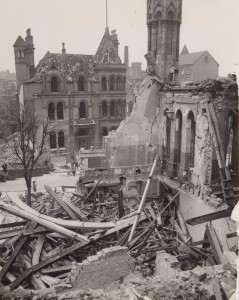
Bomb damage to the Shakespeare Street Buildings, Nottingham University College, 1941 (Ref: UMP 2/1/42/2)
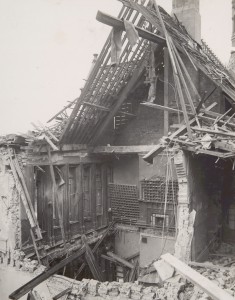
Bomb damage to the Shakespeare Street Buildings, Nottingham University College, 1941 (Ref: UMP 2/1/42/4)
The attack by the German Luftwaffe began shortly after midnight on the night of the 8th-9th May 1941. By the time the all-clear siren sounded at about 4.30am, eleven separate raids by bombers had targeted the city’s factories and industrial sites, including Raleigh and Boots.
Terrible as it was, the damage could have been considerably worse without the Starfish decoy system at Cropwell Butler. Starfish sites were areas of countryside designed to divert night-time enemy incendiary attacks from the real target. After the first wave of bombers, the decoy sites would be set on fire to mimic a burning town, which the subsequent aeroplanes would, hopefully, hone in on.
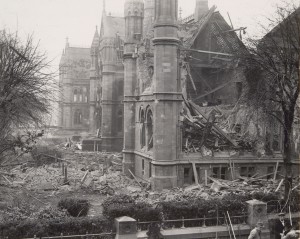
Bomb damage to the Shakespeare Street Buildings, Nottingham University College, 1941 (Ref: UMP 2/1/42/6)
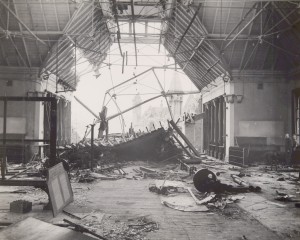
Bomb damage to the Shakespeare Street Buildings, Nottingham University College, 1941 (Ref: UMP 2/1/42/7)
The decoys worked, and many of the 400 or so bombs dropped that night fell in the Vale of Belvoir. Since 1940, staff and students from University College Nottingham (the forerunner to the University of Nottingham) had volunteered for regular fire-watching duties at both their city centre and University Park campuses, keeping an all-night vigil in readiness for any incendiary and explosives bomb attacks. That attack came in the early hours of the 9th, when the buildings on Shakespeare Street took a direct hit. Two of the fire-watchers on duty suffered minor injuries but carried on their duties with ‘steadiness and coolness’, according to UCN’s Annual Report. They were incredibly fortunate to have escaped lightly: a direct hit to the Co-Op bakery on Meadow Lane killed 48 employees and 1 member of the Home Guard, and injured 20 others who had sought refuge in the air raid shelter in the basement.
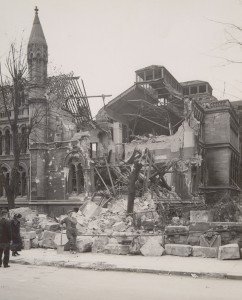
Bomb damage to the Shakespeare Street Buildings, Nottingham University College, May 1941 (Ref: UMP 2/1/42/5)
The photographs here were taken by the University College to record the damage caused. Parts of the Gothic Revival building were in rubble; the windows were shattered and roof tiles blown off from the force of the blast; and the walls still standing were covered in cracks and craters where shrapnel had hit. The west wing bore the brunt of the bombing and the Mining and Textiles Departments, including the laboratories, were destroyed. The rest of the building was, in the words of the University Council ‘scarred and heavily shaken’. Looking at the extent and severity of the damage it is remarkable that within a week the building had been repaired and restocked enough that classes could resume.
Despite this disruption, the only student in the Mining Department scheduled to sit his final exams in summer 1941, 23-year old Frederick Boam, passed and was awarded his BSc (Engineering) Mining.
These and other records from the University Archives are held at Manuscripts & Special Collections at King’s Meadow Campus. To make an appointment to view the archives and rare books, please contact us. For more information about our collections please visit our website, read our newsletter Discover, or follow us @mssUniNott.

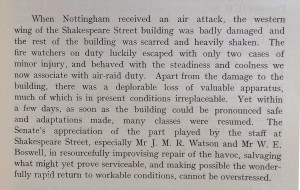

Is there any records of the bombing and distruction of 39 ryeland cresent during ww2
Could you reply to my enquiry regarding the bombing of 39 ryeland cresent the meadows nottingham
On the night meadow lane was bombed my fathers house took a direct hit from a german bomb he lived at 39 ryeland cresent sited next door to the cresent public house in the meadows nottingham my father had football and swimming medals he had won representing nottinghamshire his father was a proffessional footballer playing for notts county around 1916/1920 both lost their cups medals in the distruction of his house two coin sized medals were found by wardens and returned to my father which my son now has ,I know this is fact yet I can find no reports on this ,the maps pre war show 39 their then after the war the space where 39 was is now the pubs car park ,where later in life my dad parked his hovringham gravels works bus which he used to pick up drivers to take to work
Do you know if any info exists reporting on this particular incident.
Please email me with any info
Thank you a charlesworth
I have a mystery I would like to solve. In the Bombing Raid of Nottingham on May 8/9th 1941, my great Uncle, Paul Norris, was killed. He lived at 24 Old Musters road, West Bridgeford. The only record of his death I could find was in a military one where he is described as “a civilian”. I do not know where he is buried or why he is even mentioned in that list. As far as the family knows he had no connection with the military. Could you help or point me in the right direction please.
Hello Philip, have you got a copy of his death certificate? This will list his occupation and show whether or not he had any military connection.
A quick search online shows the death of a Paul Norris, aged 37, was registered in the June quarter (i.e. April/May/June) of 1941 in the Basford registration district. The reference is 7b 218. You can use this information to order his death certificate from the GRO: https://www.gov.uk/order-copy-birth-death-marriage-certificate
We don’t have any burial records here at the University, but they are available online for a fee from https://www.deceasedonline.com There is a Paul Norris buried on the 17 May 1941 in Nottinghamshire. The exact details of where are available for a fee.
I hope this helps!